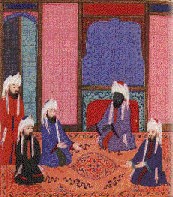
To next page
Ibn al Jawzi: Tanwir al-Ghabash fi fadl al-Sudan wa al-Habash (d1200) (The Illumination of the darkness on the Merits of the Blacks and Ethiopians). from Baghdad
-------------------------------------------------
Taken from: Imran Hamza Alawiye, Ibn Jawzi�s Apologia on Behalf of the Black People and Their Status in Islam
In his introduction:
I saw a group of the best Ethiopians broken-hearted and sad because of the darkness of their color. So I informed them that deference is based upon the doing of good, not upon physical beauty. This book, which is concerned with many of the Ethiopians and the Sudan, I dedicated to them.
Chapter 2
The cause of the darkness of their color
The author said, as far as color is concerned, it would appear that there is no obvious cause for it. Nevertheless we have already reported that after the death of Nuh, his sons divided the earth. The person who divided the earth among them was Falagh b. Abir. Sam�s sons settled in the centre of the earth, so blackness and whiteness existed among them. Yafit�s sons� settled in the (direction of) northerly and easterly winds, thus a red and ruddy complexion existed among them. Ham�s sons however, settled in the (direction of) southerly and westerly winds, and so their color changed.
However it is neither true nor authentic that when Nuh�s body appeared naked and Ham did not cover it, Nuh cursed him and consequently Ham became black��
Chapter 4
The kingdoms of the black people and their extent.
Abd�l Rahman b. Muhammad al Qazaz informs us on the authority of al-Nanur b. Hilal that he said; The earth is 24,000 farsakhs and of these 12,000 belong to the blacks, 8,000 to the people of al-Rum, 3,000 to the Persians and 1,000 to the Arabs��
Chapter 5
The virtues combined in black peoples temperaments.
Among these virtues are strength and willpower, and that produces bravery. We remember the Abyssinians for their generosity, excellent manners, inoffensiveness, cheerfulness, eloquence and being well-spoken, ease of expression and pleasantness of diction��
Chapter 19
The most brilliant in knowledge among the black people
Among those from Mecca was Ato b. Rabah, also called Abu Rabah. He embraced islam�.He destingwished himself by his knowledge and by his piety�..
His name was Abu Thabit b. Dinar Abu Yahya, and he was a freedman of the tribe of Asad Kufi. He was an eminent scholar. He learned under Ibn Abbas and Ibn Umar�. He was a very religious man, and he once spend a 100,000 dirhams on the poor. He was a black man.
Yazid b. Abu Habid: He was an eminent scholar�.
Makhul al-Shami: Abu abd Allah was an eminent jurist. He belonged to Amr b. Sa�id b. al Asi, who gave him to a man from the tribe of Hudhayl in Egypt. He was set free there. Makhul said: I did not leave Egypt until I was certain that I had learned all that there was to be learned. Then I traveled to Medina, and I did not leave Medina until I was certain that I had learned all that there was to be learned there�.
Ibrahim b. al-Mahdi b. al-Mansur
He was known as Abu Ishaq. He was a very black man, very learned and eloquent, and an excellent poet. He was acknowledged as caliph. (by the tribe of al-Abbas only)�.He died in the year 741AD and the caliph al Mu-tasin led the funeral prayer.
Abd Allah b. Hatim �l-Sulami
He was a great emir of Khurasan. He was a very knowledgeable man. Many wars happened during his period.
Chapter 20
The (black) poets and those among them who imitated poetry.
Among the (black people�s) great poets is Antara b. al-Shadad. His mother was a black Zanj. He composed many outstanding poems�.
Among their poets was Suhaym, a slave from the tribe of al-Hashas�.
Among(the black poets) was Nasib Abu Mihjan Abu Mihjan the poet was the freedman of Abd al Aziz b. Marwan and he was a blackman�.Muhammad b. Abu Mansur informs us:�.A Zanj women came out of one of the camel litters and set down on the prepared carpets. Then a Zanj man came out and sat down. Then a man leading a camel passed by us, singing the following line: Would like that I could be reunited with Zaynab before the caravan departs. Tell her, even if you are bored with me, my hart will never tire of you. Suddenly the Zanji women jumped on the Zanji man, hit him, beat him and said; You have revealed my identity to people. God will expose you similarly. I said ; Who is this? They said to me: That is the poet Nasib and this is Zaynab�..
Abu Dulana the poet: (d777AD) His name was Zand b. al-Jun. He was a freedman of the tribe of Asad�..Muhammad b. Abd al Baqi informed us on the authority of Ibn Jabir that he said: I entered a Zanj town and I saw a Zanj women grinding rice and crying. She was saying something which I did not understand. I asked a learned man and he said that she was saying:
I cast my eyes right and left
But I did not see anyone who my heart could love except God.
I came to you in humility, with deeds you already knew of,
And by your generosity you will forgive my sins.
Your hands are not hidden even if the (list of) sins is long,
And your generosity spreads East and West�.
Chapter 22
The pious and ascetic people from among (the blacks)
Among those whose names are known, apart from the aformented companions (of the Prophet) are:
Abu Mu�awiya al-Aswad who is also called al-Yaman Turk Tursus�.the freedman of the Abu Ja�far, was the commander of the faithful, and he used to say to the people; Make use of me, for I�m your servant. I was purchased with the spoils of war�.
Dhu�l-Nun b. Ibrahim Abu al-Fayd al Masri. He was of Nubian origin�.
Abu al-Khayr al-Tinati: He lived in al-Taynat which was a village in Antioch�.
Muqbil al-Aswad�.
Hamid al Aswad (in Mecca)�.
Suhayb al Aswad (a black slave in Mecca)�.
Those religious black people and ascetics whose names were not known��
A black religious man from Abadan�. There was a Zanj in Abadan with peppery hair and he was living in a rough abode. Taking some things with me, I asked as to his whereabouts. When he saw me he smiled and pointed to the ground with his hand. I saw some shining dirhams and dinars around me. Then he said to me, Give me what you have with you. I gave him and fled, frightened by his behavior.
Chapter 23
The religious and virtuous women from among the black people.
Maymuna �l-Sawda. (from Kufa)�.
Sha�wana from the tribe of al-Alba�..
Tuhiyya �l-Nubiyya�..
(many of whom the name is unknown)
Chapter 24
Those who preferred black slave girls to white ones and those who loved them, and those who died for their love of them.
�.. My father said to me: There was a man in Basra from al-Mahalaba who was in love with a black Zanj women who belonged to his neighbor. He kept putting pressure on her master until (he allowed) him to buy her. She greatly occupied his mind at the expense of his family. A group of them including his brothers, criticized him for that but he ignored what they said�..
(this is a chapter filled with love poems)
Ibn al-Marzuban reported on the authority of al-Harith that he said, Al-Farazdaq took a Zanji slave girl to be his concubine, and she bore him a girl. He loved her and he would praise the Zangi race. �.
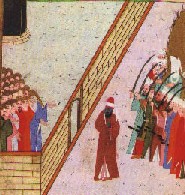



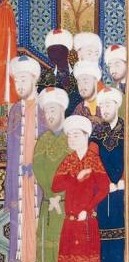
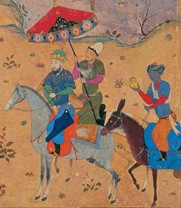
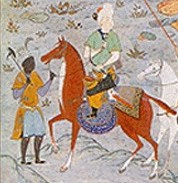


-----------------------------------------------------
Taken from: D.S. Richards; The annals of the Saljiq Turks
On 10 May 1095 the Vizier Amid al-Dawla Abu Mansur emerged and marked out the line of the wall around the Harem, and with surveyors he measured it. He ordered taxes for the required expenditure to be taken from the people�s estates and houses. He allowed the common folk to celebrate and take part. The inhabitants of the quarters brought arms, flags, trumpets and drums, and also pick-axes and crowbars, and various sorts of amusements, such as flutes, mimes and shadow plays. The people of the Gate of Degrees created something in the shape of an elephant from reed mats covered with pitch, with people underneath making it move, and similarly they made a giraffe.. ..
Note: We have problems understanding why the common people in Baghdad where so oriented to Africa in the year 1095. The normal (even in our days) is that people create cars, big puppets, animals etc for these events that touch something in their daily life. Their knowledge of giraffes must have come from East-Africa as Egypt (the other great exporter) was since a century in the hands of their enemies the Fatimid's. The only acceptable explanation I found was that this was a reenacting of the passing by at Baghdad of the elephant and giraffe from N-India to Constantinople which had happened about that time and which I also mention.